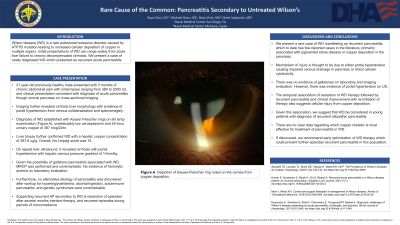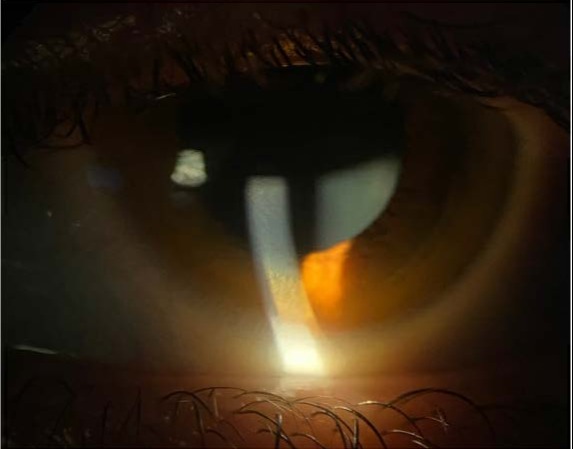Sunday Poster Session
Category: Liver
P1076 - Rare Cause of the Common: Pancreatitis Secondary to Untreated Wilson’s Disease
Sunday, October 22, 2023
3:30 PM - 7:00 PM PT
Location: Exhibit Hall

Has Audio
- RC
Ryan Choi, DO
Naval Medical Center
San Diego, CA
Presenting Author(s)
Ryan Choi, DO1, Michael Sikes, DO1, Brian Park, MD2, Brett Sadowski, MD1
1Naval Medical Center, San Diego, CA; 2Naval Medical Center, Okinawa, Okinawa, Japan
Introduction: Wilson disease (WD) is a rare autosomal recessive disorder caused by ATP7B mutation leading increased cellular deposition of copper in multiple organs. Initial presentations of WD can range widely from acute liver failure to chronic decompensated cirrhosis and have neurologic manifestations. Including dystonia and Parkinson’s Disease like movements. We present a case of newly diagnosed WD which presented as recurrent acute pancreatitis (AP).
Case Description/Methods: A 21-year-old previously healthy male presented with 3 months of chronic abdominal pain with initial lipase ranging from 384 to 2000 U/L and clinical presentation consistent with diagnosis of AP, albeit with normal cross-sectional imaging. Basic labs showed elevated liver enzymes. Imaging further revealed cirrhotic liver morphology with evidence of portal hypertension from venous collateralization and splenomegaly of unclear etiology. Diagnosis of WD established with Keyser Fleischer rings on slit lamp examination (figure A), undetectably low ceruloplasmin and 24-hour urinary copper of 367 mcg/24hr. Liver biopsy further confirmed WD with a hepatic copper concentration of 387.6 ug/g. On repeat liver ultrasound, it revealed cirrhosis with portal hypertension with hepatic venous pressure gradient of 14mmHg. Given the possibility of gallstone pancreatitis associated with WD, MRCP was performed and unremarkable. Furthermore, no alternative etiology of AP was discovered after workup for hypertriglyceridemia, alcohol/ingestion, autoimmune pancreatitis, and genetic syndromes were unremarkable. Supporting recurrent AP secondary to WD is resolution of episodes after several months trientine therapy, and recurrent episodes during periods of noncompliance.
Discussion: We present a rare case of WD manifesting as recurrent pancreatitis, which to date has few reported cases in the literature, primarily associated with pigmented stone disease or copper deposition in the pancreas. After establishing the diagnosis, the temporal association of cessation of WD therapy followed by recurrent pancreatitis and clinical improvement with re-initiation of therapy favor copper deposition in pancreas as the key mechanism in pathogenesis. Given this association, we suggest that WD be considered in young patients with diagnosis of recurrent idiopathic pancreatitis. If discovered, we recommend early optimization of WD therapy which could prevent further episodes recurrent pancreatitis in this population.

Disclosures:
Ryan Choi, DO1, Michael Sikes, DO1, Brian Park, MD2, Brett Sadowski, MD1. P1076 - Rare Cause of the Common: Pancreatitis Secondary to Untreated Wilson’s Disease, ACG 2023 Annual Scientific Meeting Abstracts. Vancouver, BC, Canada: American College of Gastroenterology.
1Naval Medical Center, San Diego, CA; 2Naval Medical Center, Okinawa, Okinawa, Japan
Introduction: Wilson disease (WD) is a rare autosomal recessive disorder caused by ATP7B mutation leading increased cellular deposition of copper in multiple organs. Initial presentations of WD can range widely from acute liver failure to chronic decompensated cirrhosis and have neurologic manifestations. Including dystonia and Parkinson’s Disease like movements. We present a case of newly diagnosed WD which presented as recurrent acute pancreatitis (AP).
Case Description/Methods: A 21-year-old previously healthy male presented with 3 months of chronic abdominal pain with initial lipase ranging from 384 to 2000 U/L and clinical presentation consistent with diagnosis of AP, albeit with normal cross-sectional imaging. Basic labs showed elevated liver enzymes. Imaging further revealed cirrhotic liver morphology with evidence of portal hypertension from venous collateralization and splenomegaly of unclear etiology. Diagnosis of WD established with Keyser Fleischer rings on slit lamp examination (figure A), undetectably low ceruloplasmin and 24-hour urinary copper of 367 mcg/24hr. Liver biopsy further confirmed WD with a hepatic copper concentration of 387.6 ug/g. On repeat liver ultrasound, it revealed cirrhosis with portal hypertension with hepatic venous pressure gradient of 14mmHg. Given the possibility of gallstone pancreatitis associated with WD, MRCP was performed and unremarkable. Furthermore, no alternative etiology of AP was discovered after workup for hypertriglyceridemia, alcohol/ingestion, autoimmune pancreatitis, and genetic syndromes were unremarkable. Supporting recurrent AP secondary to WD is resolution of episodes after several months trientine therapy, and recurrent episodes during periods of noncompliance.
Discussion: We present a rare case of WD manifesting as recurrent pancreatitis, which to date has few reported cases in the literature, primarily associated with pigmented stone disease or copper deposition in the pancreas. After establishing the diagnosis, the temporal association of cessation of WD therapy followed by recurrent pancreatitis and clinical improvement with re-initiation of therapy favor copper deposition in pancreas as the key mechanism in pathogenesis. Given this association, we suggest that WD be considered in young patients with diagnosis of recurrent idiopathic pancreatitis. If discovered, we recommend early optimization of WD therapy which could prevent further episodes recurrent pancreatitis in this population.

Figure: Depiction of Kayser-Fleischer ring noted on the left cornea from copper deposition.
Disclosures:
Ryan Choi indicated no relevant financial relationships.
Michael Sikes indicated no relevant financial relationships.
Brian Park indicated no relevant financial relationships.
Brett Sadowski indicated no relevant financial relationships.
Ryan Choi, DO1, Michael Sikes, DO1, Brian Park, MD2, Brett Sadowski, MD1. P1076 - Rare Cause of the Common: Pancreatitis Secondary to Untreated Wilson’s Disease, ACG 2023 Annual Scientific Meeting Abstracts. Vancouver, BC, Canada: American College of Gastroenterology.
